
|
Old Testament
New Testament
Gospels
Acts
Paul's Letters
General Letters
Revelation
Topical Studies
Beginning the Journey (for new Christians). en Español

|
Old Testament
New Testament
Gospels
Acts
Paul's Letters
General Letters
Revelation
Topical Studies

|
Home
Bible Studies
Articles
Books
Podcasts
Search
Menu
Donate
About Us
Contact Us
FAQ
Sitemap
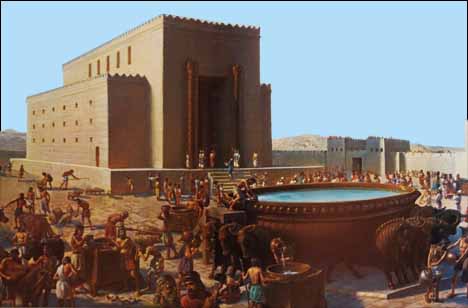 Peter V. Bianchi, 'Solomon's Temple' (1967), detail of illustration in Everyday Life in Bible Times (National Geographic Society, 1967), pp. 220-222. Editorial consultant: James B. Pritchard, archaeologist. Illustration is in chapter 'In the Days of Israel's Glory,' by G. Ernest Wright, archaeologist. Larger image. |
Solomon's crowning achievement is the completion of the temple. By all accounts, it is magnificent. Built during an era of peace by a wealthy Israelite king, it is intended to be a physical representation on earth of the glory of Yahweh.
Compared to the tabernacle in the wilderness, it is of large proportions, made of carefully dressed stone on the outside and gilded cedar within. Its entrance is flanked by two immense bronze pillars, and in the courtyard in front of it stands a massive bronze basin for cleansing and a large altar. But I'm getting ahead of myself.
3.1 Temple Site (2 Chronicles 3:1)
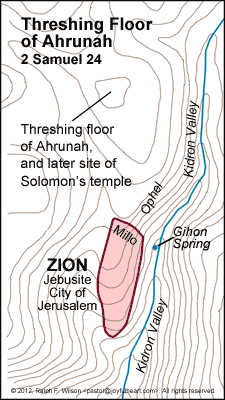 Threshing Floor of raunah. Larger map. |
The site of the temple is on one of the hills just north of the original Jebusite fortress at Jebus or Jerusalem.
The history of the temple site goes back to Abraham, who was commanded by God,,
"Take your son, your only son, Isaac, whom you love, and go to the region of Moriah. Sacrifice him there as a burnt offering on one of the mountains I will tell you about." (Genesis 22:2)
The Chronicler, and both Jewish and Muslim traditions, link Mount Moriah with the hilltop in ancient Jerusalem that Araunah the Jebusite used to thresh his grain.
The Chronicler describes the temple site.
"Solomon began to build the temple of the Lord in Jerusalem on Mount Moriah, where the Lord had appeared to his father David. It was on the threshing floor of Araunah the Jebusite, the place provided by David." (2 Chronicles 3:1)
The site was considered a holy place since God had revealed his presence there.84
3.2 David's Preparations for the Temple (1 Kings 5; 1 Chronicles 22, 28, 29)
As we saw in Lesson 1.3, David had made a lot of preparations for the temple before his co-regency with Solomon (1 Chronicles 22:5).
"2 David gave orders to assemble the aliens living in Israel, and from among them he appointed stonecutters to prepare dressed stone for building the house of God. 3 He provided a large amount of iron to make nails for the doors of the gateways and for the fittings, and more bronze than could be weighed. 4 He also provided more cedar logs than could be counted, for the Sidonians and Tyrians had brought large numbers of them to David." (1 Chronicles 22:2-4)
David Gives Solomon Plans for the New Temple (1 Chronicles 28))
Towards the end of his reign, David calls together all of the officials of the kingdom, administrators of all sorts, as well as his mighty men and warriors. He exhorts Solomon publicly, then delivers to him the plans for the temple in the sight of all.
"11 David gave his son Solomon the plans for the portico of the temple, its buildings, its storerooms, its upper parts, its inner rooms and the place of atonement. 12 He gave him the plans of all that the Spirit had put in his mind for the courts of the temple of the Lord and all the surrounding rooms, for the treasuries of the temple of God and for the treasuries for the dedicated things." (1 Chronicles 28:11-12)
We refer to the First Temple as "Solomon's Temple," but in a real sense David is the designer under the direction of the Holy Spirit. The text goes on to suggest that even the details of the weights of precious metals in the various vessels is determined (1 Chronicles 28:14-18). David concludes:
"All this, I have in writing from the hand of the Lord upon me, and he gave me understanding in all the details of the plan." (1 Chronicles 28:19)
Fundraising for the Temple (1 Chronicles 29:5-9)
Now David calls on the wealthy noblemen for financial commitment to the project. I have given of my fortune, he says. Now you give from yours for this great task.
"5b 'Who is willing to consecrate himself today to the Lord?'
6 Then the leaders of families, the officers of the tribes of Israel, the commanders of thousands and commanders of hundreds, and the officials in charge of the king's work gave willingly.... 9 The people rejoiced at the willing response of their leaders, for they had given freely and wholeheartedly to the Lord. David the king also rejoiced greatly." (1 Chronicles 29:5b-6, 9)
Finally, David offers a prayer of praise to his majestic God. In the prayer, he acknowledges that they are able to give only by God's grace.
"But who am I, and who are my people, that we should be able to give as generously as this? Everything comes from you, and we have given you only what comes from your hand." (1 Chronicles 29:14)
The passage is often quoted in stewardship sermons in our day -- and rightly so.
"O Lord our God, as for all this abundance ... comes from your hand, and all of it belongs to you." (1 Chronicles 29:16)
Everything you and I have belongs to God. So when we give to God, we are but giving back to him what already belongs to him.
According to the Chronicler, David
- Mines copper for the bronze items in the temple (1 Chronicles 18:8),
- Secures many cedar logs (1 Chronicles 22:3-4),
- Prepares detailed plans for the temple (1 Chronicles 28),
- Contributes his own wealth towards the temple (1 Chronicles 28:1-4),
- Fundraises for the temple among the nobles (1 Chronicles 29:5-9),
- Stockpiles materials for the temple, and
- Develops friendly relations with Hiram, King of Tyre, who could supply the necessary timbers and craftsmen for the temple in the future.
Once Solomon secures his kingdom, he is free to begin where David leaves off. The time is now right because, as Solomon reports, "now the Lord my God has given me rest on every side, and there is no adversary or disaster" (1 Kings 5:4a). There would be adversaries later (Lesson 6.2), but for now, there is peace.
"Solomon gave orders to build a temple for the Name of the Lord and a royal palace for himself." (2 Chronicles 2:1)
Partnership with Hiram, King of Tyre (1 Kings 5)
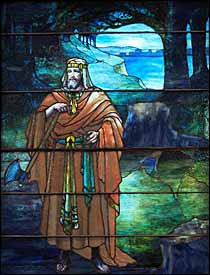 'Hiram King of Tyre' (1911), Tiffany Studios stained glass, 8 x 5.5 ft.; Masonic Care Community, Tompkins Memorial Chapel, Utica, New York. |
Hiram had provided the cedar logs for David's palace (2 Samuel 5:11; 2 Chronicles 3:3). Now Hiram takes steps to maintain the relationship.
"When Hiram king of Tyre heard that Solomon had been anointed king to succeed his father David, he sent his envoys to Solomon, because he had always been on friendly terms with David." (1 Kings 5:1)
Solomon announces his intention:
"I intend to build a house for the name of the Lord my God, as the Lord said to David my father, 'Your son, whom I will set on your throne in your place, shall build the house for my name.'" (1 Kings 5:5)
(We'll explore what "a house for my name" means in Lesson 4.2.) Now Solomon writes to Hiram:
"Give orders that cedars of Lebanon be cut for me. My men will work with yours, and I will pay you for your men whatever wages you set. You know that we have no one so skilled in felling timber as the Sidonians." (1 Kings 5:6)
Hiram responds with the details regarding the needed cedar and pine logs.85
"9 My men will haul them down from Lebanon to the sea, and I will float them in rafts by sea to the place you specify. There I will separate them and you can take them away. And you are to grant my wish by providing food for my royal household." (1 Kings 5:8-9)
Phoenician Craftsmen (2 Chronicles 2:7)
Solomon also arranges for skilled Phoenician craftsmen to work on the project.
"Send me a man skilled to work in gold and silver, bronze and iron, and in purple, crimson and blue yarn, and experienced in the art of engraving, to work in Judah and Jerusalem with my skilled craftsmen, whom my father David provided." (2 Chronicles 2:7)
Hiram responds by sending Huram-Abi, a man whose father is from Tyre, while his mother is an Israelite from Dan in northern Israel (2 Chronicles 2:13). Skilled stone workers are also recruited from Phoenicia (1 Kings 15:18).
In exchange, Solomon agrees to give Hiram "twenty thousand cors86 of wheat as food for his household, in addition to twenty thousand baths87, of pressed olive oil" each year (1 Kings 5:11), as well as other payment.88 As we'll see in Lesson 5.3, Solomon's partnership with Hiram is mutually lucrative in sea trade as well.
Conscripted Labor (Corvée) from Israelites (1 Kings 5:13-14)
Building the temple doesn't come without pain to the citizenry. David had used forced labor in his building projects (2 Samuel 20:24). Now Solomon greatly increases it.
"13 King Solomon conscripted laborers from all Israel--thirty thousand men. 14 He sent them off to Lebanon in shifts of ten thousand a month, so that they spent one month in Lebanon and two months at home. Adoniram was in charge of the forced labor." (1 Kings 5:13-14)
Carr observes, "The institution of tribute or corvée involves involuntary, unpaid labor or other service for a superior power -- a feudal lord, a king, or a foreign ruler."89 Corvée is common throughout the ancient world.90
But this isn't just a one-time project. Solomon builds aggressively throughout his long reign. The author of Kings writes:
"This is the account of the forced labor King Solomon conscripted to build the Lord's temple, his own palace, the supporting terraces, the wall of Jerusalem, and Hazor, Megiddo and Gezer." (1 Kings 9:15)
The Bible contains only a hint of criticism of Solomon's palace building (1 Kings 6:38-7:1). However, the prophet Jeremiah lambasts Judah's final king, Jehoiakim, for the extravagance of his palace built with forced labor.
"Woe to him who builds his
palace by unrighteousness,
his upper rooms by injustice,
making his countrymen work for nothing,
not paying them for their labor." (Jeremiah 22:13)
Corvée is a heavy burden requiring Israelites to be away from their own farms and businesses for a month at a time. As we'll see in Lesson 6.4, after Solomon's death the people complain bitterly to his son Rehoboam, the new king.
"Your father put a heavy yoke on us, but now lighten the harsh labor and the heavy yoke he put on us, and we will serve you." (1 Kings 12:4)
Forced Labor from Non-Israelites (1 Kings 5:15-16)
Besides conscripted labor from the Israelites, there is forced labor from the non-Israelites living in Israel -- essentially slave labor. For the temple project,
"17 Solomon took a census of all the aliens who were in Israel, after the census his father David had taken; and they were found to be 153,600. 18 He assigned 70,000 of them to be carriers and 80,000 to be stonecutters in the hills, with 3,600 foremen over them to keep the people working." (2 Chronicles 2:17--18; 1 Kings 5:15-16).
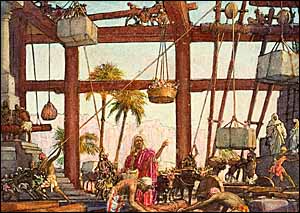 John Millar Watt, illustrator, 'Building Solomon's Temple' (1962), gouache on board, original 10 x 7 in., illustration in Look and Learn, issue no. 45, 24 Nov 1962, p. 8. |
"7 All the people left from the Hittites, Amorites, Perizzites, Hivites and Jebusites (these peoples were not Israelites), 8 that is, their descendants remaining in the land, whom the Israelites had not destroyed -- these Solomon conscripted for his slave labor force, as it is to this day. 9 But Solomon did not make slaves of the Israelites for his work." (2 Chronicles 8:7--9a)
Ironically, Solomon is using aliens as slave-labor in the same way that the Israelites endured slavery as foreigners in Egypt.
"17 At the king's command they removed from the quarry large blocks of quality stone to provide a foundation of dressed stone for the temple. 18 The craftsmen of Solomon and Hiram and the men of Gebal91 cut and prepared the timber and stone for the building of the temple." (1 Kings 5:17--18)
Skilled craftsmen make the decisions, but the grunt work was done by slave labor who work in the quarries to cut, then dress or trim to size, and then, with back-breaking effort, transport the huge blocks from the quarry to the temple site for exact placement by masons in the temple foundation and structure.
3.3 Solomon Builds the Temple (1 Kings 6; 2 Chronicles 3)
Solomon begins construction in the fourth year of his reign (1 Kings 6:1). 1 Kings 6 and 7 (termed the "temple archives" by some scholars) contain "a detailed, generally unembellished, and obviously contemporaneous description of the temple construction."92
Quarrying White Limestone (1 Kings 6:7)
The main buildings are built of quarried white limestone.93
"In building the temple, only blocks dressed at the quarry were used, and no hammer, chisel or any other iron tool was heard at the temple site while it was being built." (1 Kings 6:7)
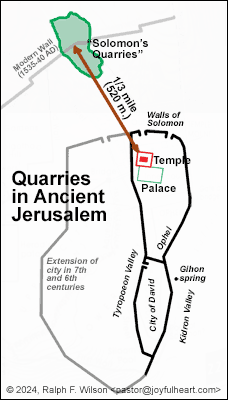 Quarries in Ancient Jerusalem (larger map) |
R. K. Harrison explains,
"The stonemasons normally sought cracks running along the grain of the rock and enlarged them by driving in wedges, often of wood, at regularly spaced intervals until a length of stone broke away. Once such a block had been dislodged, it was subdivided by the drilling of holes in a straight line and then split by other wedges. Freshly quarried rock is softer than rock that has been exposed to the air for some time and is therefore not as difficult for the stonemasons to remove and shape."e."94
Zedekiah's Cave, also known as "Solomon's Quarries," is a five-acre remnant of the biggest quarry in Jerusalem that once stretched all the way from the Garden Tomb to the walls of the Old City. It is located in today's Muslim Quarter, north of the temple mount. Friedman tells us:
"The oldest and most enduring legend about the cave is that it served as the quarry for King Solomon when he built the First Temple. It was a particularly important quarry because it was rich in white massif Melekeh limestone, which, because of its strength, its suitability for carving and its resistance to erosion, was used for all royal buildings."95
If this was the quarry used, the fully-dressed stones would have been hoisted from the quarry, then transported perhaps 1/3 mile or 520 meters as the crow flies from the quarry to the temple site, where they would be hoisted again for final placement in the wall or foundation.
Temple Description (1 Kings 6)
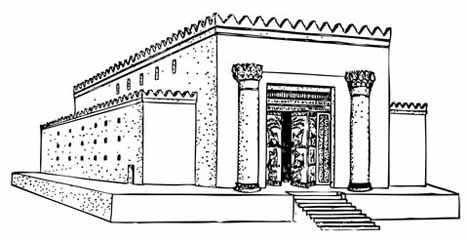 Solomon's Temple (Steven's reconstruction), drawn from specifications prepared by W. F. Albright and G. Ernest Wright. G. Ernest Wright, Biblical Archaeology (Philadelphia: Westminster Press, 1957). |
Instead of going through all the details of the temple, I'll summarize briefly.
In the text, temple dimensions are measured in cubits. A cubit is the length of a man's forearm from the elbow to the middle finger, standardized from time to time. We estimate one cubit as about 18 inches or 1.5 feet (about 46 centimeters). Based on this, the exterior temple dimensions are:
- Length: 60 cubits = 90 feet (27.6 m)
- Width: 20 cubits = 30 feet (9.2 m)
- Height: 30 cubits = 45 feet (13.8 m)
The core of the temple seems to have two sections like the Tabernacle in the Wilderness before it -- the holy place and the holy of holies. Solomon's Temple is larger than the tabernacle -- twice the length and width of the tent, and three times as tall. ll.
The temple has similarities in layout with other Near Eastern temples of the time -- which isn't surprising. Wiseman says:
"Solomon seems to have modified the current contemporary design of a 'longroom temple,' included a special Holy of Holies at the end, and added surrounding structures."96
| Tabernacle in the Wilderness |
Solomon's Temple | |
|
Sanctuary length |
45 feet (13.7 m) |
90 feet (27.6 m) |
| Sanctuary width | 15 feet (4.7 m) | 45 feet (13.8 m) |
| Sanctuary height | 15 feet (4.7 m) | 45 feet (13.8 m) |
| Porch length | 15 feet (4.6 m). | |
| Porch height | unknown | |
|
Pillar
height (including capitals) |
34.5 feet (10.5 m) |
In addition to the main temple, there is some kind of entry way or portico97 in front of the temple (not well understood by scholars) that projects out beyond the main building about 15 feet (4.6 m). Thus, with the porch, the length of the entire building is about 70 cubits = 105 feet (32.2 m), plus the width of the storerooms we'll study in a moment. At the top of the main hall are narrow openings to let in light and air.98 The building is roofed with beams and cedar planks (1 Kings 6:9).
Stairs bring priests from the outside into the raised main hall of the temple. The high priest would ascend another set of stairs to enter the yet higher holy of holies, or inner sanctuary (1 Kings 6:8).
The main building is surrounded on three sides by a three-story structure containing storage chambers used for storage of offerings and equipment, and, perhaps, accommodation of temple personnel.99
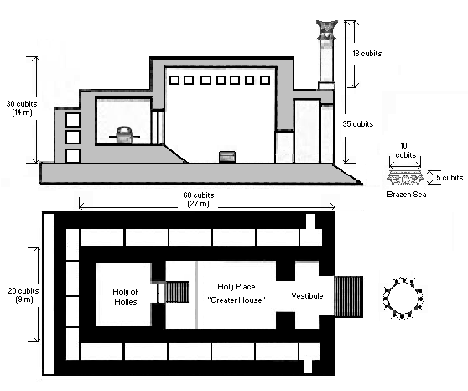 Solomon's Temple. Illustration appeared in WikiCommons, of unknown origin. GNU Free Documentation License, Version 1.2 Other image. |
Thus, Solomon's Temple has four parts:
- Holy Place, "main hall," or "nave."
- "Holy of Holies, "inner sanctuary"
- Portico or entry area in front of the main building.
- Storage rooms surrounding the main building.
The generic word for temple is bayit, "house, place, temple." The main idea is dwelling or habitation.100 In addition, there are specific designations for each of the two main rooms:
1. Holy Place. In 1 Kings 6:17, "main hall" (NIV), "nave" (ESV, NRSV), "greater house" (KJV) is hêkāl, "As in extra-biblical literature this loanword from Sumerian/Akkadian essentially represents a king's dwelling quarters, i.e., a palace."101 In 2 Chronicles 3:5 it is called literally, "the great house."102
2. Holy of Holies. In 1 Kings 6:18-19 this is called the "inner sanctuary" (NIV), "innermost part" (ESV, NRSV), the "house within" or "oracle" (KJV). It is also called the "Most Holy Place" (NIV, ESV, NRSV) and "most holy house" (KJV) (1 Kings 6:16; 2 Chronicles 3:8).103 This room contains the ark of the covenant representing God's throne.
Promise of God's Presence (1 Kings 6:11-14)
During the construction of the temple, Solomon receives a special word from the Lord, probably through a prophet:
"11 The word of the Lord came to Solomon: 12 'As for this temple you are building, if you follow my decrees, carry out my regulations and keep all my commands and obey them, I will fulfill through you the promise I gave to David your father. 13 And I will live among the Israelites and will not abandon my people Israel.'" (1 Kings 6:11-13)
Wow! Having God live among us -- that is our real desire. We desire God to dwell with us in the temple that is the church. And we desire to have God live within us, in the temple of our bodies. This presence of the Holy Spirit is our immense privilege, far beyond God's promise to Solomon! (More on that in Lesson 3.6 below.)
Temple Decorations (1 Kings 6:15-35; 2 Chronicles 3:4b-17)
As mentioned above, the interior of the temple is divided into the main hall and the holy of holies. The main hall is paneled with cedar boards floor to ceiling. The floor is made with pine or perhaps cypress104 boards from Lebanon. The wall decorations are "carved with gourds and open flowers" (1 Kings 6:18).
The Chronicler adds details not in the 1 Kings account.
"He overlaid the inside with pure gold. 5 He paneled the main hall with pine and covered it with fine gold and decorated it with palm tree and chain designs. 6 He adorned the temple with precious stones. And the gold he used was gold of Parvaim.105 7 He overlaid the ceiling beams, doorframes, walls and doors of the temple with gold, and he carved cherubim on the walls." (2 Chronicles 3:4b--7)
The Holy of Holies or "inner sanctuary" -- the place where the original Ark of the Covenant would rest -- is like a cube in Solomon's Temple, each dimension being 20 cubits = 30 feet = 9.2 m. The inner sanctuary is raised, entered by steps from the Holy Place. Inside it is overlaid with "600 talents of fine gold" -- a huge fortune in gold! (2 Chronicles 3:8-9).
Inside the Holy of Holies is a pair of cherubim carved from olive wood, overlaid with gold. These are massive -- 15 feet (4.6 m) high, each with a 15-foot (4.6 m) wingspan. They stand side-by-side, wingtips touching each other in the center, and touching the walls on either side (1 Kings 6:23-28; 2 Chronicles 3:10--13). Cherubim, palm trees, and flowers also decorate the walls, carved in bas-relief. The floors in both the Holy Place and Holy of Holies are covered with gold (1 Kings 6:30; 2 Chronicles 3:7b).
Both the entrances to the Holy Place and Holy of Holies are wooden doors made of olive wood, decorated with carved cherubim, palm trees and open flowers, covered in gold (1 Kings 6:31-35). The Chronicler mentions "the curtain of blue, purple and crimson yarn and fine linen, with cherubim worked into it" (2 Chronicles 3:14), reminiscent of the curtains in the Tabernacle in the Wilderness.
The average Israelite never sees the inside of the temple, of course, since only the priests and Levites are allowed inside. However, we are told that it is designed to be beautiful, to reflect the earthly beauty of God's creation.
"Splendor and majesty are before him;
strength and glory are in his sanctuary." (Psalm 96:6)
Temple Courtyards
In front of the porch or portico of the temple are two massive bronze pillars, each 27 feet (8.2 m) high and 5.7 feet (1.75 m) in diameter.106 These are crowned with elaborate bronze capitals another 7.5 feet (2.3 m) high. The pillars are named -- Jakin to the south, Boaz to the north (1 Kings 7:15-22; 2 Chronicles 3:15--17).
The author of Kings appears to distinguish three courtyards:
- Great court (1 Kings 7:12) that surrounded the temple and royal buildings, made with doors of bronze (2 Chronicles 4:9).
- Middle Court (2 Kings 20:4; 1 Kings 7:8), a kind of court for the palace; and
- Inner Court (1 Kings 6:36; Jeremiah 36:10), also known as the courtyard of the priests (2 Chronicles 4:9).107
3.4 Temple's Furnishings (1 Kings 7:13-51; 2 Chronicles 4:1-5:1)
The text of 1 Kings includes a detailed account of Solomon's Palace (1 Kings 7:1-12). For now, we'll keep our focus on the temple, and consider Solomon's Palace in Lesson 5.1.
"He also made the basins and shovels and sprinkling bowls." (1 Kings 7:40)
The "basins," "pots," or "lavers" seem to be large cauldrons used for cooking the meat for the fellowship offerings (Leviticus 7:15, 17).108 The "shovels" were for handling the ash left from the burnt offerings. The "sprinkling bowls" or "basins" were for ritual use with blood or water (Exodus 27:3).109
The furnishings for Solomon's temple are on a grand scale.
Compared to the moveable furniture constructed for the portable Tabernacle in
the Wilderness, they are massive.
|
|
Tabernacle in the Wilderness |
Solomon's Temple |
|
Altar |
Wood covered with bronze, 7.5 feet square (2.3 m), 4.5 feet high (1.4 m). |
Bronze, 30 ft (9.15 m) square, 15 feet high (4.6 m) |
|
Basin or Laver |
Portable, dimensions not given |
Large
basin. Bronze, 15 feet (4.6 m) diameter, 7.5 feet (2.3 m) high. |
|
Lampstand |
One, dimensions not given. |
Ten lampstands, probably solid gold, no dimensions. |
|
Table of showbread |
One table. Wood covered with gold, 3 feet (0.91 m) long, 1.5 feet (.46 m) wide, 2.25 feet (.69 m) high. |
One golden table.110 |
|
Altar of incense |
One altar, wood covered with gold, 1.5 feet square, 3 feet (0.91 m.) high |
One gold altar, dimensions not given. |
|
Courtyard |
One (150 x 75 feet; 45.7 x 22.9 m) |
Three courtyards |
Bronze
In addition, there are ten moveable bronze basins in the courtyard on both sides of the temple (1 Kings 7:27-39).
"In them the things to be used for the burnt offerings were rinsed, but the Sea was to be used by the priests for washing." (2 Chronicles 4:6)
The Sea refers to the immense bronze basin that stands before the altar, 15 feet (4.6 m) diameter, 7.5 feet (2.3 m) high. It sits on twelve huge bronze oxen.
Solomon reigns in the early part of the Iron Age that followed the Bronze Age. By this time, bronze craftsmanship is well-developed in the Middle East. For the temple, this involves casting the massive decorated bronze basin and bronze pillars, as well as the construction of the moveable bronze basins on chariot wheels.111 These large items were "cast in clay molds in the plain of the Jordan between Succoth and Zarethan" (1 Kings 7:46) using the lost wax process of manufacture. Excavations in this area have produced much copper slag and clay suitable for digging molds.112
What is left of the silver and gold donated for the temple is placed "in the treasuries of the Lord's temple" (1 Kings 7:51; 2 Chronicles 5:1), the three stories of storerooms built around three sides of the temple building.
Finally, the temple is complete!
"37 The foundation of the temple of the Lord was laid in the fourth year [of Solomon's reign], in the month of Ziv. 38 In the eleventh year in the month of Bul, the eighth month, the temple was finished in all its details according to its specifications. He had spent seven years building it." (1 Kings 6:37-38)
God Dwells in Awesome Glory (Revelation 21)
This morning, I finished reading the Book of Revelation in my daily devotions. It is impossible to ignore the opulence of God's heavenly residence as depicted in chapters 21 and 22! The Holy City of God is described in gargantuan terms -- massive walls of a cubic city 12 thousand stadia in length, breadth, and height, with foundation stones of precious gems, walls of jasper, a city built of pure gold, 12 gates, each made with a massive pearl (Revelation 21:15-21)
"The great street of the city was of pure gold, like transparent glass" (Revelation 21:21b).
There is no temple seen in John's vision "because the Lord God Almighty and the Lamb are its temple" (Revelation 21:22). The city glows with the glory of God and the Lamb (a reference to Jesus) as its light (Revelation 21:23).
Any temple Solomon could build, no matter how opulent, is just a mere imitation of the true glory and presence of God. How much more will heaven be when you and I are ushered into Christ's presence in "the Father's House" (John 14:1-4).
Church Buildings and Solomon's Temple
Solomon's Temple -- and later, Herod's Temple -- are grand, designed to impress people with God's glory. The early Christians, on the other hand, meet in the front rooms of the wealthy, in lecture halls, and in catacombs.
After Christianity becomes a legal religion in Rome in 313 AD, Christians begin to build churches and cathedrals. (A cathedral is the name of the church building where the bishop has his seat or cathedra.) If you travel in the United Kingdom and Europe today, you can see many examples of beautiful buildings built for the glory of God -- and for the glory of the wealthy families who contributed money to build them.
Today, in an era where many new churches are being formed around the world, just finding an affordable place to meet is a challenge. After they become established, congregations begin to build permanent structures in which to worship. At this point they face an inevitable challenge:
- Should the church building be grand and glorious to point people to God? Or
- Should it be functional in order to save money for the mission of the church?
After all, multiplying church buildings is not the central mission of the Church. Rather, our mission is to spread the Good News of Jesus that sets men and women free from sin to enjoy God's grace and presence.
I remember a stark contrast on my first visit to train pastors in western Kenya in the Fall of 2007. My final day there involved joyful Sunday worship and preaching in a church made of mud and wattle, with a dirt floor, a corrugated metal roof, and wood benches to sit on. The worship was wonderful, with joyous dancing and several messages over four hours. Two days later, I attended formal worship in St. Paul's Cathedral in London, the second largest church in Christendom. In which location was the presence of God most real to me? With my dear Christian friends in the slums of Kenya. That taught me an important lesson: the most important factor is not the building but the presence of God within.
Q10. How do church buildings
relate to the central mission of the Church? What is the place of building worship
buildings (such as Solomon's Temple) that express the beauty and glory of God?
What is the place of building functional houses of worship that conserve
resources for other tasks?
https://www.joyfulheart.com/forums/topic/2253-q10-buildings/
3.5 The Temple Sacrifices and Worship
We've examined Solomon's Temple and its furnishings. Now we need to focus on what goes on in the temple -- primarily sacrifices, praise, and prayer -- though most of this isn't spelled out in detail in 1 Kings or 2 Chronicles. (For more on temple worship under Solomon, see Lesson 4.5.)
Prayers and Songs
The word "psalm" actually means "song." The psalms are meant to be sung, and many are eventually used in temple worship. David, and later Solomon, are instrumental in setting up groups of Levitical singers, responsible for instrumental and vocal praise.113
"David told the leaders of the Levites to appoint their brothers as singers to sing joyful songs, accompanied by musical instruments: lyres, harps and cymbals." (1 Chronicles 15:16)
There are three main families of singers -- the sons of Heman, Asaph, and Ethan, as well as others. They perform twice daily for the morning and evening sacrifices and prayers, and carry these traditions for generations of Levites who follow them.
"In keeping with the ordinance of his father David, [Solomon] appointed the divisions of the priests for their duties, and the Levites to lead the praise and to assist the priests according to each day's requirement." (2 Chronicles 8:14)
Typical Cycle of Temple Sacrifices
There are five different kinds of tabernacle sacrifices spelled out in Leviticus (Appendix 3. Five Kinds of Temple Sacrifices or Offerings, a couple of which are mentioned below). Here, however, we're focusing on a cycle of regular sacrifices offered in Solomon's temple, day by day, week by week, and year by year. Solomon speaks:
"Now I am about to build a temple for the Name of the Lord my God and to dedicate it to him for burning fragrant incense before him, for setting out the consecrated bread regularly, and for making burnt offerings every morning and evening and on Sabbaths and New Moons and at the appointed feasts of the Lord our God. This is a lasting ordinance for Israel." (2 Chronicles 2:4; cf. 13:11)
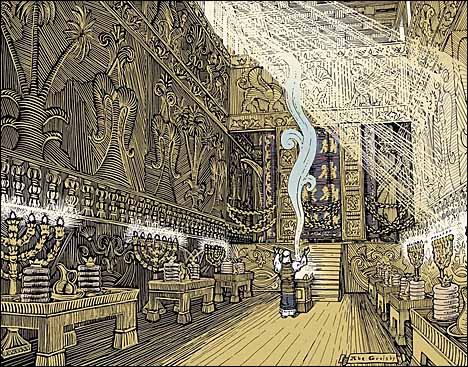 Abe Geelsby, Priest worshiping at altar of incense inside the Holy Place of Solomon's Temple.116 Unknown date or source. Larger image. |
Let's look briefly at each of these.
1. Burning fragrant incense (Exodus 30:1-10). A special blend of very expensive fragrant incense (Exodus 30:35-37) is burned both morning and evening on the gold altar of incense in the Holy Place in conjunction with various prayers (Exodus 30:1-10). Priests also use censers.114 Zechariah is offering incense in the Second Temple when the Angel Gabriel appears to him announcing the birth of John the Baptist (Luke 1:8-23). In Jesus' day, about half a pound of incense is used every morning and every evening.115 Incense is sometimes used to represent the prayers of God's people being offered before him (Revelation 5:8; 8:3-4).
"May my prayer be set before you like incense;
may the lifting up of my hands be like the evening sacrifice." (Psalm 141:2)
Burning incense to foreign gods is seen as worshiping those gods and is repugnant to all faithful followers of Yahweh.
2. Setting out consecrated bread regularly (Leviticus 24:4-9). Each Sabbath, twelve freshly-baked loaves of showbread, one for each tribe, are placed before the Lord on a special table in the Holy Place, symbolically providing sustenance for the Yahweh's court. These are also referred to as the "Bread of the Presence," that is, the bread placed in God's presence. They are eaten by priests at the end of the week.
3. Morning and Evening Burnt Offerings (Exodus 28:38-39; Numbers 28:1-8). One lamb is offered as a burnt offering in the morning, another at twilight.
4. Sabbath Sacrifices (Numbers 28:9-10). In addition to the regular morning and evening offerings, on the Sabbath the priests offer two yearling lambs, along with a drink offering and a grain offering. One male goat is also offered as a sin offering.
5. New Moon Sacrifices (Numbers 28:11-15). Each new lunar month the priests offer a burnt offering of two young bulls, one ram, and seven yearling male lambs, along with grain offerings,
6. Annual appointed feasts. According to the Law there are five feasts, though Israelites are only required to gather in Jerusalem for three of them.117 These are celebrated in Solomon's time (Lesson 4.5):
"... The three annual feasts -- the Feast of Unleavened Bread, the Feast of Weeks and the Feast of Tabernacles." (2 Chronicles 8:12--13)
- Feast of Passover and Unleavened Bread celebrates the Exodus and is connected with the barley harvest.118
- Feast of Harvest, sometimes called the Feast of Weeks or Pentecost (in the New Testament) celebrates the wheat harvest, seven weeks following Passover.119
- Feast of Ingathering or Feast of Tabernacles or Booths is a general harvest festival in the fall.120
In addition to these, we presume the priests celebrate the Feast of Trumpets121 and the Day of Atonement or Yom Kippur,122 though there is little mention of them in the Old Testament outside of Leviticus.
Repentance Is Necessary with Sacrifices
It is important to realize that the sacrifices are more than bare ritual; under the Old Covenant, they are God's means of atonement for sin. But to be effectual, they must be accompanied by sincere repentance. Sacrifice without real repentance has always been repugnant to God; just as Christians who sin flagrantly because they know God will forgive them make a travesty of grace. The Lord speaks through the prophet Isaiah:
"'The multitude of your sacrifices
-- what are they to me?' says the LORD.
'I have more than enough of burnt offerings,
of rams and the fat of fattened animals;
I have no pleasure
in the blood of bulls and lambs and goats....
Stop bringing meaningless offerings!
... Your hands are full of blood;
wash and make yourselves clean.
Take your evil deeds out of my sight!
Stop doing wrong, learn to do right!
Seek justice, encourage the oppressed.
Defend the cause of the fatherless,
plead the case of the widow.'" (Isaiah 1:11,13, 15b-17)
God calls us to be a holy people for whom holiness becomes a new way of life, rather than rebellion and sin as the norm. The sacrifice of Christ for our sins is designed to do what we cannot do -- to cleanse us from sin. But he expects us to repent and cooperate with the Holy Spirit who seeks to change our hearts -- and our behavior! Yes, God's forgiveness is always there for us when we sin, but he calls us to a far better way of life! The apostle John wrote:
"My dear children, I write this to you so that you will not sin. But if anybody does sin, we have one who speaks to the Father in our defense -- Jesus Christ, the Righteous One. He is the atoning sacrifice for our sins, and not only for ours but also for the sins of the whole world." (1 John 2:1-2)
3.6 Temples and Sacrifices for New Testament Disciples
With the destruction of the Second Temple by the Romans in 70 AD, Judaism loses its central worship center, the temple and its sacrifices. Judaism adapts by moving towards rabbinic Judaism, with an emphasis on the study and interpretation of the Torah, the oral law, and other sacred texts. The synagogue replaces the temple as the focal point of Jewish life.
Followers of Jesus, on the other hand, realize afresh that Christ's death on the cross makes temple sacrifices obsolete. The Book of Hebrews (written in the 60s AD before the destruction of the temple) is designed to help believers understand how Christ fulfills all the requirements of sacrifices.
"11 Day after day every priest stands and performs his religious duties; again and again he offers the same sacrifices, which can never take away sins. 12 But when this priest [Christ] had offered for all time one sacrifice for sins, he sat down at the right hand of God. 13 Since that time he waits for his enemies to be made his footstool, 14 because by one sacrifice he has made perfect forever those who are being made holy." (Hebrews 10:11--14)
Under the inspiration of the Holy Spirit, John the Baptist points to Jesus and declares:
"Behold, the Lamb of God, who takes away the sin of the world." (John 1:29)
Jesus' sacrifice on the cross is the final sacrifice! Any animal sacrifice to Yahweh pales before the cross. Any human altar for sacrifice is obsolete. Any sacrifice or offering that we might make to God is tawdry in comparison.
Q11. How does an understanding of Old Testament
sacrifice help us understand Jesus' death on the cross?
https://www.joyfulheart.com/forums/topic/2254-q11-cross/
Temples in the Era of the Spirit
In the Christian community now, the Holy Spirit facilitates God's presence as well as our spiritual worship. The terms "temple," "offering," and "sacrifice," once present literally, now take on figurative meanings.
The Apostle Paul explains that there is a sense that our very bodies are "temples" of the Holy Spirit (1 Corinthians 6:19-20), in other words, like Solomon's temple, a place where God dwells.
There is also a sense in which the church congregation is like a "temple," and sacred in God's sight -- and should be sacred to us (1 Corinthians 3:16-17). "In him you too are being built together to become a dwelling in which God lives by his Spirit" (Ephesians 2:22). Peter describes believers as stones in God's temple.
"4 As you come to him, the living Stone -- rejected by men but chosen by God and precious to him -- 5 you also, like living stones, are being built into a spiritual house to be a holy priesthood, offering spiritual sacrifices acceptable to God through Jesus Christ." (1 Peter 2:4--5)
Offerings and Sacrifices in the Era of the Spirit
These "spiritual sacrifices" today are exclusively confined to what we offer to God from the heart. Just what kinds of offerings do we offer to God? Here is a helpful though incomplete list.
1. Loving God and loving our neighbor. Jesus reminds us that love is vastly more important than any temple sacrifices that might be offered.
"To love him with all your heart, with all your understanding and with all your strength, and to love your neighbor as yourself is more important than all burnt offerings and sacrifices." (Mark 12:33)
Showing love to our neighbors is seen as a "sacrifice" -- doing good works and sharing (koinonia) with others in need.
"And do not forget to do good and to share
with others,
for with such sacrifices God is pleased." (Hebrews 13:16)
Loving God is also closely related to a second sacrifice.
2. Lives surrendered to God in obedience. When we obey God in the way we live, we worship God.
"Offer your bodies as living sacrifices, holy and pleasing to God -- this is your spiritual act of worship."123 (Romans 12:1)
Jesus made it clear that he desires not just outward obedience, but obedience from the heart (Matthew 6:1-5). The Psalmist captures this idea well in his prayer:
"May the words of my mouth
and the meditation of my heart
be pleasing in your sight,
O Lord, my Rock and my Redeemer." (Psalm 19:14)
3. Financial Gifts are also referred to in terms of "sacrifices" in the New Testament.
"I have received from Epaphroditus the gifts
you sent.
They are a fragrant offering,
an acceptable sacrifice,
pleasing to God" (Philippians 4:18)
4. Proclaiming the gospel. Paul relates evangelism to acting as a priest offering sacrifices. Paul talks about his call --
"To be a minister of Christ Jesus to the Gentiles with the priestly duty124 of proclaiming the gospel of God, so that the Gentiles might become an offering125 acceptable to God, sanctified by the Holy Spirit" (Romans 15:16).
5. Praise
The author of Hebrews exhorts us:
"Through Jesus, therefore, let us continually offer to God a sacrifice of praise -- the fruit of lips that confess his name." (Hebrews 13:15; quoting Hosea 14:2)126
6. Prayers. From the angel's words to Cornelius the Centurion, we see two other acts of worship referred to in terms of a "memorial" from the world of sacrifices -- prayers and alms.
"Your prayers and your alms have ascended as a memorial before God." (Acts 10:4)
The prayers of the saints are seen as incense coming up to God (Revelation 5:8; 8:4; Psalm 141:2).
7. Alms, gifts for the poor. Help for the poor, of course, is an extension of our love for our neighbor.127 (More on alms in Lesson 5.6.)
Q12. Should worship be a "sacrifice" for us in the sense
that it costs us something in time, effort, or focus? Which of the New
Testament forms of "sacrifice" and "offerings" are most meaningful for you?
Which are most difficult for you?
https://www.joyfulheart.com/forums/topic/2255-q12-sacrifice/
Prayer
 Available in book formats - PDF, Kindle, Paperback |
Father, thank you for the great privilege we have of the Holy Spirit dwelling within us so that we can have open fellowship with you. Thank you for Jesus' sacrifice for our sins that makes us holy in your sight by your grace. In Jesus' holy name, we pray. Amen.
Lessons for Disciples
Solomon's Temple offers lessons at several levels. Here are but a few lessons we can learn from it.
- David's preparations for the temple stockpiled all sorts of materials, encouraged others to give towards the project, and set an expectation for success (1 Chronicles 22, 28, 29). Our preparations for future ministry are necessary, even if we won't get the credit for it.
- David prays, "Everything comes from you, and we have given you only what comes from your hand." (1 Chronicles 29:14b). That teaches us that our possessions and resources are God's, not ours.
- The main purpose of Solomon's Temple was to provide a holy place for God to dwell in the midst of his people (1 Kings 6:13), even though it could not contain him. In a similar way, our bodies are to be temples, dwelling places of the Holy Spirit.
- The Temple was designed to be beautiful and splendid, as would befitting of God's House (Psalm 96:6). God's dwelling place in heaven is even more glorious (Revelation 21).
- Church buildings can be inexpensive and functional at the beginning, but can attempt to reflect something of God's glory when the congregation can afford it. However, the Church's central mission is in reaching the lost, not in building splendid churches.
- Singing worship abounded in the Temple (2 Chronicles 8:14) as it should in our churches.
- Various kinds of sacrifices were offered in the temple, for atonement as \well as for celebration and fellowship. Since Christ's death on the cross as a sacrifice for our sins, animal
- Rather than offer animal sacrifices, Christians now offer spiritual worship, such as: love and good works, surrendered and obedient lives, financial gifts, proclaiming the gospel, praise, prayers, and alms for the poor.
Many more lessons can be learned from understanding the details for the tabernacle and temple and sacrifices, but these lessons are a good beginning.
Endnotes
[84] David numbers the people for military purposes contrary to God's command. To stay angelic retribution against the Israelites, the prophet Gad tells David to build an altar on this site, which he then purchases from Araunah. After David sacrifices and prays there, God appears to him and lifts the plague from Israel (2 Samuel 24).
[85] 2 Chronicles 2:8 and 9:10f also mention algum. It is difficult to be sure what this is. But if this is not another word for pine, it may be Eastern Savin or Greek Juniper (Savina excelsa), a pyramidal tree growing in the Lebanon range (R.K. Harrison, "Algum," ISBE 1:94).
[86] A "cor" or "homer" is a dry measure that constituted about 394 liters or about 11 bushels, though the exact amounts evade us ("Homer," ISBE 2:749; E. M. Cook, "Weights and Measures," ISBE 4:1050; Ezekiel 45:11, 14).
[87] A bath is a liquid measure of about 5.5 US gallons or 21 liters. The bath is one tenth of a homer or cor ("Bath," ISBE 1:438).
[88] Apparently, the treaty with Hiram also calls for an additional 20,000 cors of barley and 20,000 baths of wine (2 Chronicles 2:8-10).
[89] G. Lloyd Carr, mas, TWOT #1218.
[90] D. J. Kelly, "Levy," ISBE 3:117.
[91] Gebal is an ancient Phoenician port, north of Tyre that was under Hiram's control.
[92] S. Westerholm, "Temple," ISBE 4:760.
[93] S. Westerholm, "Temple," ISBE 4:761.
[94] R. K. Harrison, "Quarry," ISBE 4:6-7.
[95] Thomas L. Friedman, "Quarrying History in Jerusalem," New York Times, 1 December 1985, Sec. 10, p. 19. Wikipedia article, "Zedekiah's Cave."
[96] Wiseman, 1&2 Kings, p. 102. He cites Christopher J. Davey, 'Temples of the Levant and the Buildings of Solomon,' Tyndale Bulletin 31, 1980, pp. 107-146. "Searching for the Temple of King Solomon: How the 'Ain Dara temple in Syria sheds light on King Solomon in the Bible and his famous temple," Bible History Daily, 23 July 2023.
[97] "Portico" (NIV), "porch" (KJV), "vestibule" (ESV, NRSV) is ʾêlām, "portico," was apparently "an enclosed porch or entrance hall, since it could have windows (Ezekiel 41:26) and is compared to a palace (I Kings 7:8)" (Herbert Wolf, TWOT #45j).
[98] "Narrow clerestory windows" (NIV), "windows with recessed frames" (ESV, NRSV), "windows of narrow lights" (KJV) is two words, shĕqûp, "frame, casing of windows" (TWOT #2458b); and ḥallôn, "window" ... "an opening in a building which provided light and air, usually high up in the wall and below the eaves for security purposes They were not glazed and seldom shuttered" (Donald J. Wiseman, TWOT #660c).
[99] Stephen Westerholm, "Temple," ISBE 4:761.
[100] We are familiar with this word in the placename Bethlehem, beth ("house") + lehem ("bread") or Bethel, "house of God." Synonyms include: ʾohel is "tent," meʿārâ "cave," bîrâ "palace, castle," hēkāl "palace, temple," ḥāsēr "settlement," mōshāb "dwelling," māʿôn "refuge," miqdāsh "sanctuary," and mishkān "tabernacle" (Louis Goldberg, bayit, TWOT #241).
[101] Leonard J. Coppes, hêkāl, TWOT #493.
[102] The adjective gādôl, is "great" (TWOT #315d), used with bayit, "house."
[103] Literally, bayit, "house," with the noun qōdesh, both in the singular and plural forms. The doubled word in Hebrew emphasizes the importance. The word qōdesh means, "apartness, holiness, sacredness, hallowed, holy," that is, "the essential nature of that which belongs to the sphere of the sacred and which is thus distinct from the common or profane" (Thomas E. McComiskey, TWOT #1990a). The Holy of Holies is also referred to with the noun dĕbîr, (from dābār, "to speak") "rear room, the cubical holy of holies of a Syrian type of temple." 2 Chronicles 5:7; 1 King 6:5 (Holladay, dĕbîr, p. 66). "Dĕbîr ... refers to the holy of holies and is translated sixteen times in KJV and ASV as "oracle," but RSV and modern versions translate as sanctuary, inner sanctuary, inner temple, inner room and other such terms. It is not used of the holy of holies of the wilderness tabernacle" (Earl S. Calland, dĕbîr, TWOT #399g).
[104] "Pine" (NIV), "cypress" (ESV, NRSV), "fir" (KJV) is bĕrôsh, "an evergreen anciently common in Palestine and Lebanon. Some see it as the Aleppo Pine (Pinus halepensis). Holladay (p. 47) says it is Phoenician Juniper (Juniperus phoenicea).
[105] The location of Parvaim isn't known. Possibilities might be Farwa in south Arabia or el-Farwein in north Arabia (C. G. Rasmussen, "Parvaim," ISBE 3:673).
[106] Diameter is determined by dividing the circumference of 12 cubits by pi (3.1416). 2 Chronicles 3:15 states that the pillars were 35 cubits long, rather than 18 cubits high as in 1 Kings 7:15. R. K. Harrison says, "Various methods have been suggested to reconcile this discrepancy, but it is more probable that there is a corruption in the Chronicler's number" ("Jachin and Boaz," ISBE 2:947).
[107] Stephen Westerholm, "Temple," ISBE 4:762, I,D,2.
[108] Wiseman, 1&2 Kings, p. 116. John N. Oswalt (kîyôr, TWOT #967d) sees these as "pots" instead as lavers, but I think "pot" is probably the idea here.
[109] The noun translated "sprinkling bowls" (NIV, mizrāq) comes from the verb zāraq, "scatter, sprinkle, strew" (TWOT #585a).
[110] 1 Kings 7:48. In contrast, 2 Chronicles 4:8 has ten tables, dimensions not given, though their purpose is not stated. Herod's Temple in Jesus' day had a single table for the showbread (Edersheim, Temple, p. 182). 2 Chronicles 13:11 and 29:18 have a single table. Selman comments, "Although the purpose of the tables is not given [in 2 Chronicles 4:8], the regular practice of referring suggests that these were for the 'Bread of the Presence' rather than to support the lamps" (Selman, 2 Chronicles, p. 313). Williamson (1&2 Chronicles, p. 211) disagrees: "The ten tables are not referred to elsewhere. The context and their placement strongly suggest that the Chronicler thought that the lampstands were put on them."
[111] 1 Kings 7:13-14, 23-39, 40-47; 2 Chronicles 4:2-6, 11-18.
[112] Wiseman, 1&2 Kings, p. 116.
[113] 1 Chronicles 15; 2 Chronicles 5:12-13; 7:6; 8:12-15; etc.
[114] Leviticus 10:1; 16:12; Numbers 16:6, 17, 18, 37-39, 46; 1 Kings 7:50; 2 Kings 25:15; 2 Chronicles 4:22; 26:19; Jeremiah 52:19; Ezekiel 8:11; cf. Rev 8:3, 5.
[115] Edersheim, Temple, p. 163.
[116] Note: 1 Kings 7:48 seems to indicate a single table of showbread, in contrast to 2 Chronicles 4:19, which is the basis of Geelsby's picture. See footnote 110 above.
[117] Exodus 23:14--17; Deuteronomy 16:16.
[118] Exodus 12; Leviticus 23:5-8; Numbers 28:16-25; Deuteronomy 16:1-8.
[119] Exodus 34:22a; Deuteronomy 16:9-12; Leviticus 23:16-21; Numbers 28:26-31.
[120] Leviticus 23:33-43; Deuteronomy 16:13-15; 2 Chronicles 8:13; John 7:2; Exodus 34:22.
[121] Leviticus 23:23-25; Numbers 29:1-6. J. C. McCann, Jr., Trumpets, Feast of," ISBE 4:924.
[122] Leviticus 16; 23:26-32. W. Möller, and J. B. Payne, "Atonement, Day of," ISBE 1:360-362.
[123] "Spiritual act of worship" (NIV), "spiritual worship" (ESV, NRSV), "reasonable service" (KJV) is two words: (1) logikos, "pertaining to being carefully thought through, thoughtful," here, "a thoughtful service (in a dedicated spiritual sense)" (BDAG 598); and latreia, "service or worship (of God)" (BDAG 587).
[124] "Priestly duty" (NIV), "priestly service" (ESV, NRSV), "ministering" (KJV is hierourgeō, "to act in some cultic or sacred capacity, perform holy service, act as a priest" (BDAG 471).
[125] "Offering" is phosphora, "that which is brought as a voluntary expression, 'offering'" (BDAG 887, 2).
[126] The NIV and NRSV translate Hosea 14:2 as "the fruit of our lips," but the NIV alternate reading brings out the true meaning: "offer our lips as sacrifices of bulls." The Old Testament priests offered literal offerings; we New Testament priests offer praise as our sacrifice.
[127] James 1:27; Matthew 6:1-4; Luke 12:33-34; 1 Timothy 6:17-19.
Copyright © 2026, Ralph F. Wilson. <pastor![]() joyfulheart.com> All rights reserved. A single copy of this article is free. Do not put this on a website. See legal, copyright, and reprint information.
joyfulheart.com> All rights reserved. A single copy of this article is free. Do not put this on a website. See legal, copyright, and reprint information.

